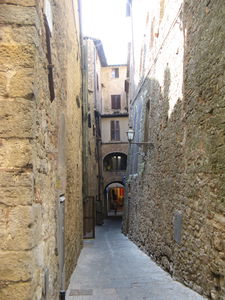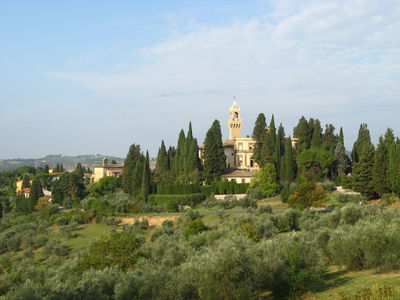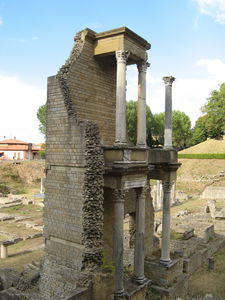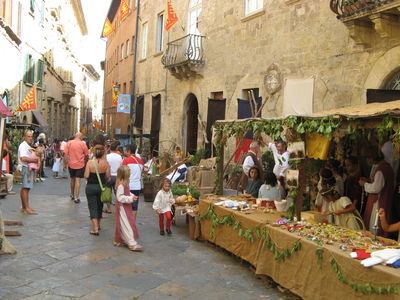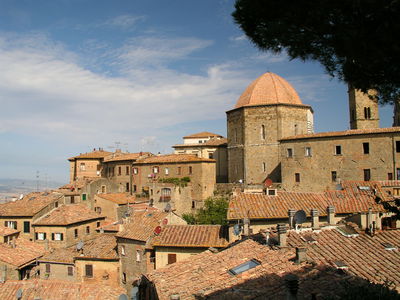The walled hilltop town of Volterra will enchant you. If you've been to Siena and to San Gimignano, you'll see this medieval town offers its own special charm and allure. The town still has traces of its Etruscan past - it was one of 12 power centers from the 4th through 6th centuries BC - as well as its Roman past. You can see all of these past eras on your visit to Volterra, starting from parts of the walls that go back to Etruscan times but built on through the Middle Ages.

Stay in Volterra
Staying in Volterra and the area nearby would make it a perfect base to explore in every direction: the coast, Chianti and Siena and more. Check out rentals by owners reviewed by our team and book your stay direct at the best prices.
The town attracts many fans of the Twilight series, who will be disappointed to learn that the movie scenes for New Moon that are supposedly Volterra were actually filmed nearly 70 miles away in Montepulciano. Despite its recent popularity among fans, it remains visited far less than nearby San Gimignano making it a great day trip when visiting Tuscany year round and in particular during the high tourist summer months. Here's our recommendations on the top sights to see in Volterra during a day (or two or three) spent exploring the town.
Visit Piazza dei Priori

Way before the writing of Twilight, I had visited this medieval town during the August medieval fair Volterra AD 1398 and fallen in love with the town's narrow medieval streets and its central piazza. You'll appreciate the beauty of the 13th century Palazzo dei Priori which sits tall over the piazza, as well as the Palazzo Pretorio across the square.

Palazzo dei Priori is the oldest town hall in Tuscany, although the tower was destroyed during an earthquake and rebuilt in the 1800s. Palazzo Pretorio's tower, on the other hand, is known affectionately as the Torre del Porcellino, or Tower of the Piglet, for the small stone form of the wild boar you'll find at the top - make sure to look for it! The palazzo was the seat of the town's mayor.
Palazzo dei Priori, Piazza dei Priori
Open: 9am-7pm from March through October
from 10am-4:30pm from November through February
Ticket: €5 full, €3 reduced
See below for info on the Volterra Card.
Visit the Duomo (Cathedral of Santa Maria Assunta) and Baptistery

Dating back to 1120, the interior of the cathedral was heavily modified in the Renaissance era in 1584 after the Council of Trent. You'll thus have a mix of Romanesque architecture (the facade) with and the an impressive and richly decorated, gilded Renaissance ceiling and several frescoed chapels.
The cathedral houses many works of art belonging to renowned Italian artists including Andrea della Robbia, Mino da Fiesole and Benozzo Gozzoli, who realized a wonderful fresco dated 1479.

The 13th century Baptistry sits across the cathedral, with an octagonal base, adorned in dark green and white marble. It is quite small and simple, but make sure to admire the octagonal marble baptismal font sculpted in 1502 by Andrea Sansovino.
The Guarnacci Etruscan Museum

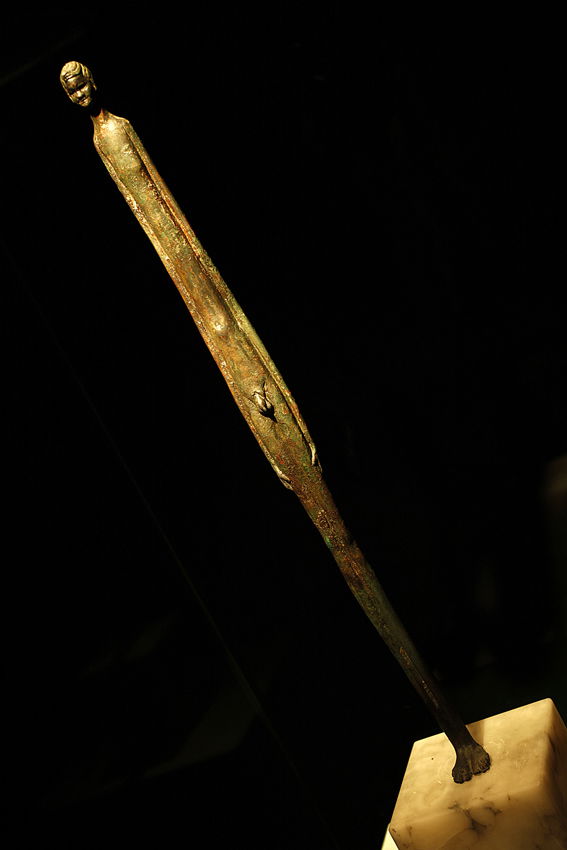
The museum houses hundreds of funeral urns from the Hellenistic and Archaic periods from the area, many carved from alabaster and tufo rock. It is also one of the oldest public museums in all of Europe, having opened its doors in 1761 by the noble Mario Guarnacci with the donation of his large archeological collection, collected over years of research and purchases, to the "public of the city of Volterra". The donation, which also includes a library with over 50,000 volumes, ensured that the city not only had a rich cultural patrimony but that the collection stayed together and not sold off.
The main attractions that merit the entire visit: the bronze statuette "Shadow of the Night" of a long nude figurine, the cinerary urn cover from the 1st century AC called "Urn of the Sposi", a terracotta sculpture of an elderly couple laying on a bed and the Stele di Avile Tite. Make sure to stop and admire the many other items made in terracotta, alabaster and other stone across the museum.
Via Don Minzoni, 15 - official site
Open: 9am-7pm from March through October
from 10am-4:30pm from November through February
Ticket: full €8; reduced €6. Closed December 25 25 and January 1.
See below for info on the Volterra Card.
The Etruscan Walls and Gates

There are 6 gates along the Etruscan walls into the city, with many sections dating from the 13th to 16th centuries. The Porta all'Arco is the oldest and only one remaining mostly intact, with features from the 5th century such as its decoration with 3 heads.
Porta San Francesco still has traces of its original frescoes, while Porta San Felice offers great views of the countryside around the town.
Roam around the Etruscan Acropolis

The Etruscan acropolis is located at the top of the hill at one of end of the park by the Medicean fortress, called Parco Enrico Fiumi. It is an area with evidence of buildings of various ages, from Etruscan to Roman to Medieval, with religious purposes. There are remains of a cistern water system, including an Augustean pool, and two buildings in the shape of temples named A and B: the first rectangular one dates back to the 2nd century BC while the second dates back to the 3rd century AC, with a podium and columns.
Open: weekends from 10am to 4pm during winter
from March through mid-November daily from 10:30am to 5:30pm
Ticket: full €5, reduced €3
See below for info on the Volterra Card.
Medicean Fortress and Porta a Selci

Experience Volterra with a Guided Tour
If you can't drive to Volterra, you can reach it with a guided tour from Florence, Siena or other city. Take a look at some of the possibilities.
From its commanding hilltop position, the enormous Medici Fortress looks out over Volterra and the surrounding countryside. This massive building is visible from miles away and characterizes the skyline of the hill upon which the city lies. The Fortress was built in 1474, exactly two years after Florence conquered Volterra following a fierce battle over the control of nearby alum mines, an important mineral used in the production of textiles. The Fortress was intended not only to protect the city, but primarily to keep the city under tight control and to prevent revolts against the new masters of the city.
The fortress consists of two parts: the old Rocca or fortress built by the Duke of Athens Gualtieri VI of Brienne, governor of Florence, in 1342 and modified by Lorenzo the Magnificent and the New Fortress, built also by Lorenzo the Magnificent in 1475. The two are connected through a curtained wall.
It is now a high security prison, so you won't be able to get inside - but you can certainly admire it from the outside. Interesting note is that inmates here participate in a rehabilitation restaurant project that has given life to special evenings called "cene galleotte" where the public can attend for a special gourmet meals.

The adjoining gate Porta a Selci leads into the city: in a simple arch, it was constructed in the 16th century to substitute the old entrance that fell during the construction of the New Fortress.
Admire the Roman Amphitheater and its Archaeological Area

Located just outside the medieval walls by Porta Fiorentina, you might encounter the Roman theater first if you park nearby making it a perfect first stop.
Built in the 1st century AD, the amphitheater sits on an older Etruscan site and is one of Italy's finest and best preserved. The amphitheater is open daily between March and November and only on weekends the rest of the year.
Behind the theater, there are remains of Roman baths from the 4th century and of the Roman forum. During the Middle Ages, this site was was used as a garbage dump so the site was completely covered. It was only after 1951 that excavations began.
If you visit in the winter when the site is closed, head up through the door and into the walled city, turn right and view the area from the terrace above on Via Lungo Le Mura del Mandorlo (free).

From above, it is easier to see the vaulted corridors that connect the stage to the back of the theater, as well as the roofed area behind the theater where its 2000 spectators could gather during intermission.
Via Francesco Ferrucci
Open: weekends from 10am to 4pm during winter
from March through mid-November daily from 10:30am to 5:30pm
Ticket: full €5, reduced €3
See below for info on the Volterra Card.
The Pinacoteca - Art Gallery

The Pinacoteca or Art Gallery, housed in the Minucci-Solaini Palace, a splendid example of late 15th century architecture traditionally attributed to Antonio San Gallo the Elder should also be on your list. Along with the Civic Museum of Volterra, the Art Gallery preserves many incredible masterpieces of art, but the one that stands particularly out is the Deposition by Rosso Fiorentino.
Both museums conserve and exhibit important works of art belonging to institutions which are no longer able to provide adequate care. While Rosso Fiorentino's Deposition is the most significant work from the collection, other important works in the collection include paintings by Taddeo di Bartolo, Alvaro Pirez and Cenni di Francesco, the Pietà by Francesco Neri of Volterra, a predella of the story of the Virgin by Benvenuto di Giovanni, two wooden sculptures by Francesco di Valdambrino, an altar piece of Christ in Glory by Domenico Ghirlandaio and the Holy Conversation and the Annunciation by Luca Signorelli from Cortona. There is also a noteworthy collection of medieval sculpture and ceramics, of medals (especially the Medici collection) and of coins.
Via dei Sarti, 1
Open: 9am-7pm from March through October
from 10am-4:30pm from November through February
Tickets: full €8; reduced €6
See below for info on the Volterra Card.
Discovering Alabaster and more at its Ecomuseum

All throughout the city, you'll see many items made from alabaster stone in many store fronts and quickly learn it is an ancient tradition in Volterra with the precious material coming from nearby quarries since Etruscan times. You can window shop and buy some souvenirs to take home, from bowls, picture frames, boxes and sculptures, all handcrafted by artisans that still follow traditional methods of working alabaster, passed down through the generations.
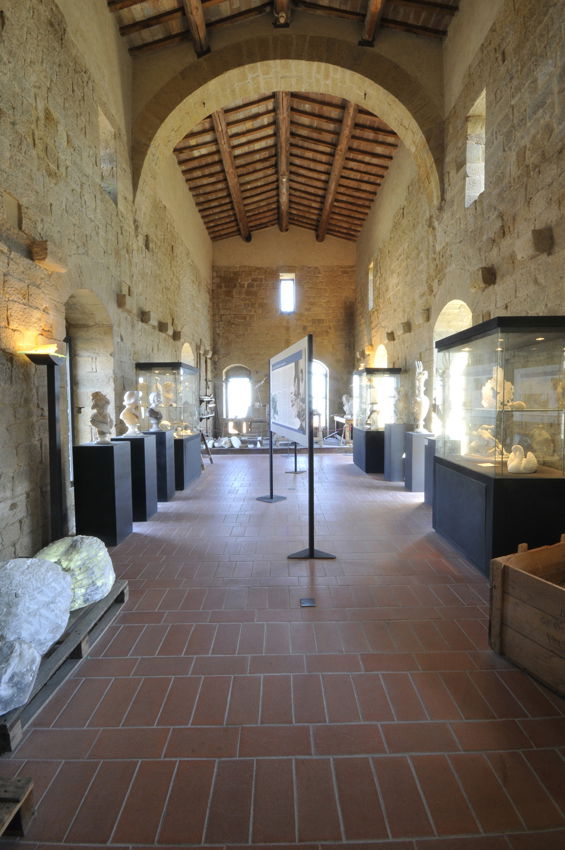
If you're interested in learning more about alabaster, then a stop at the Alabastar Ecomuseum is a must. It is an intriguing exploration of everything related to the rock, from excavation, production and sculpting to commercialization. Volterra treasures an inestimable collection of alabaster sculptures and the display in the Ecomuseum is only a small part of this heritage. You'll enjoy exploring the recreated artisan's workshop, and admiring over 300 examples from Etruscan times on to contemporary sculptures.
The visit to the Ecomuseum should also include a visit to collections such as those of the Guarnacci museum which houses a rich display of the art of alabaster carving during the Etruscan era, and Palazzo Viti, an historical home which offers a splendid array of antique alabaster artefacts.
Read more on the Alabaster Ecomuseum here.
Via dei Sarti, Palazzo Minucci Solani (in the house tower)
Open: 9am-7pm from March through October
from 10am-4:30pm from November through February
Tickets: full €8; reduced €6
See below for info on the Volterra Card.
The Volterra Card
If you're in Volterra for a day or more, and are interested in visiting many of the sites recommended above, then the best deal is to get the Volterra Card which is valid for 3 days (valid 72 hours) and includes access to the Guarnacci Etruscan Museum, the Pinacoteca (Painting Gallery), Alabaster Ecomuseum, Palazzo dei Priori, the Acropolis and Roman Theather (all recommended above).
€16 full
€24 Family (2 adults and 2 children under 16)
€13 reduced (children 6-12, over 60, Coop and TCI)
€6 Student groups (min 15 pax)
children under 6: free
Main events in Volterra
Volterragusto - events in mid-March, late October and early November showcase local produce such as cheese, white truffles, olive oil and chocolate.

Volterra AD 1398 - on the 3rd and 4th Sundays of August, the citizens of Volterra roll back time to 600 years ago, celebrating in period costume and enjoying themselves in the fun of a medieval fair. Look for the stands that offer medieval dress so that you can join in!
Maps
Download the map of the city including parking lots here:
http://www.provolterra.it/wp-content/uploads/2015/03/cartina-Volterra-A3.pdf
For more in-depth information on all of the sites recommended above, including more historical details, make sure to check out: http://www.volterratur.it/en/
How to get to Volterra
Read this article on how to get to Volterra by car (with info on parking), train and bus!
